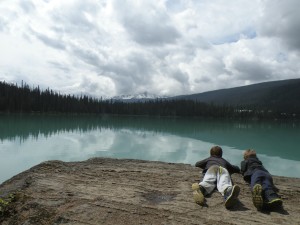Learning to be Gentle Giants

Originally appears in the Spring 2016 issue
Did your Mum have a “sun’s shining, get out of the house” rule? Mine did. In fact, “sunshine” was a subjective concept in my mother’s world and was understood more as “daylight.” If it happened to be raining or snowing, she would have our appropriate outdoor gear lined up by the door to help make our exit all the swifter. Fresh air was generally understood by her to be the magic ingredient in “happy kids.”
My fondest memories, both as a child and as an adult, are of playing in natural outdoor settings. Although I grew up only 40 minutes from Montreal, our suburban backyard was exploding with so-called “dirty knees” learning experiences. “Outside” was where my posse of friends and I discovered why salamanders hide beneath rotten logs, how snakes go about climbing steep rocks, how frogs manage to survive the winter, that a veil of cirrostratus clouds may mean rain is on its way, how to locate North via the Big Dipper, the mathematics behind igloo-construction, that snow can be made from boiling water in freezing temperatures, and the amazing various forms of water, its cycle, and its importance. We got the details by asking local experts (including my dad) and going to the library. We sought after the details because we were inspired and questions came up as we explored.
As my parents were all for simplicity and recycling, the tools we used during our explorations were thoroughly reused and simple: a well-repaired fishing net, an old bucket, our hands, and whatever lay on the forest floor that seemed useful (fallen leaves and sticks for example). The value of reducing, reusing and recycling was instilled in us from an early age.
To view the photo-rich magazine version, click here.
If you are not already a subscriber, please subscribe to read the full article
Jane Frances Powell is both a freelance environmental educator and a Program Coordinator/Instructor at The College of the Rockies, in Golden, British Columbia. She created 20 EE Activity Cards that can be used during outdoor adventures with young children, and freely downloaded from: www.inaboutandfor.blogspot.ca
Notes
[1] During their introduction to the United Nations Educational, Scientific and Cultural Organization document “The Contribution of Early Childhood Education to a Sustainable Society”, Ingrid Pramling Samuelsson and Yoshie Kaga write “There was a strong consensus that educating for sustainability should begin very early in life. It is in the early childhood period that children develop their basic values, attitudes, skills, behaviours and habits which may be long lasting. Studies have shown that racial stereotypes are learned early and that young children are able to pick up cultural messages about wealth and inequality. As early childhood education is about laying a sound intellectual, psychological, emotional, social and physical foundation for development and lifelong learning, it has an enormous potential in fostering values, attitudes, skills and behaviours that support sustainable development – e.g. wise use of resources, cultural diversity, gender equality and democracy.” (UNESCO 2008)
[2] For an excellent exploration of the importance of environmental education in early childhood education, read “Young Children and the Environment – Early Education for Sustainability” (2010), Edited by Julie M. Davis.
Leave a Reply
You must be logged in to post a comment.





